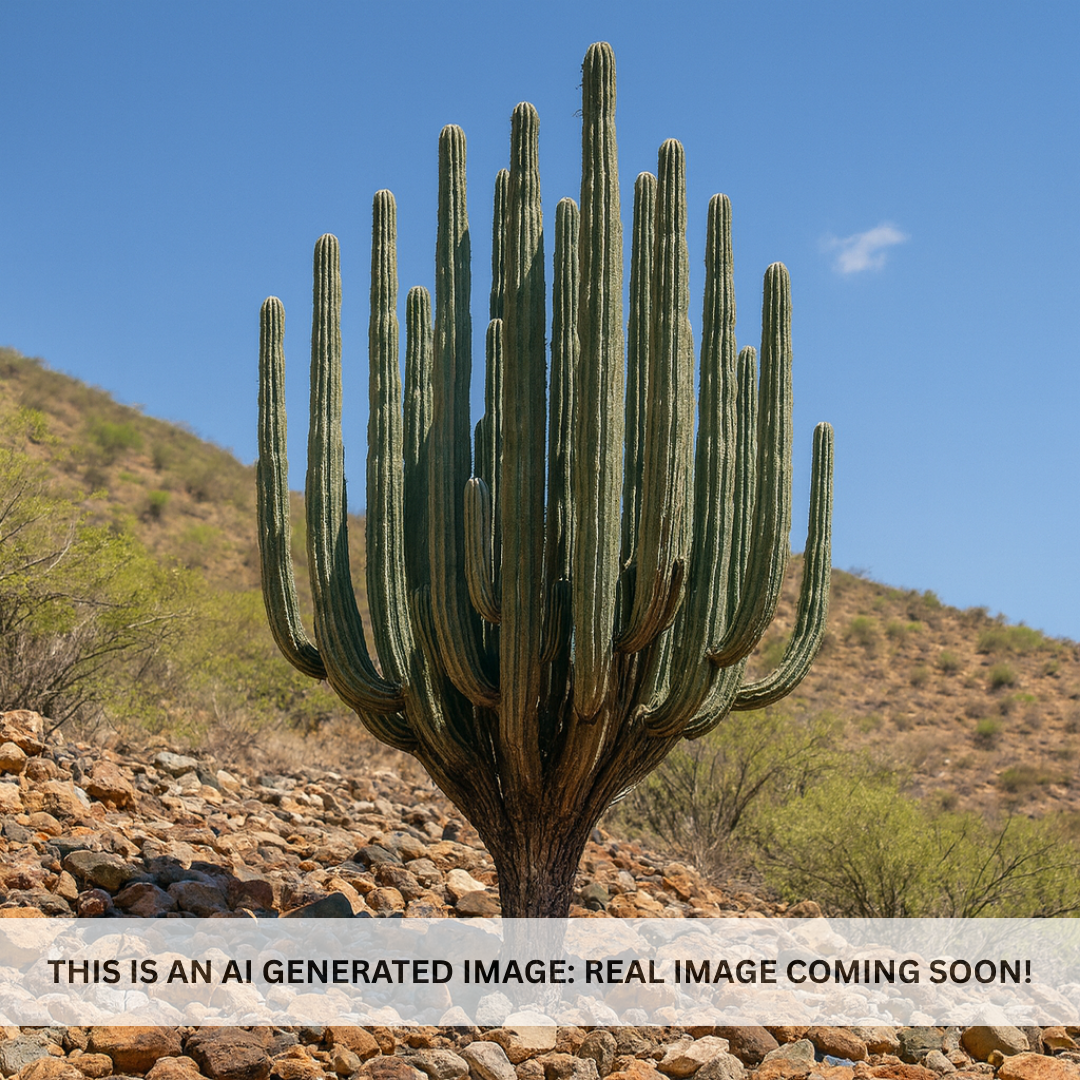My Store
Pachycereus weberi
Pachycereus weberi
Couldn't load pickup availability
Plant Type: perennial, large columnar cactus
Plant Height: 10–25 feet (can reach up to 30 feet in maturity)
Spread: 6–10 feet
Flower Color: creamy white (night-blooming)
Sun Exposure: Full sun
Pachycereus weberi: A Towering Columnar Cactus of Grandeur and Desert Majesty
Pachycereus weberi, often referred to as the Weber’s Cactus or Cardón Weberi, is a majestic, large-scale columnar cactus native to the arid regions of Mexico. Resembling a smaller, more branched cousin of the Saguaro (Carnegiea gigantea), this species is admired for its impressive vertical form, ribbed architecture, and massive presence in desert landscapes. In Arizona gardens, it serves as a statement cactus—a living sculpture that brings both gravitas and elegance to large open spaces.
Key Features of Pachycereus weberi
This species develops thick, upright columns with prominent ribs lined with short, golden-brown spines that become sparser with age. Mature plants typically form multiple vertical stems, branching from the base to create a candelabra-like silhouette that can reach over 25 feet in height.
The skin of the cactus is a cool gray-green, often taking on subtle blue tones under the Arizona sun. In late spring through early summer, mature specimens produce creamy white, tubular flowers that open at night and close by midday, attracting nocturnal pollinators such as bats and moths. These are followed by red, spiny fruits that split open to reveal seeds enjoyed by birds and other desert wildlife.
With its commanding form, symmetrical ribs, and softly reflective surface, Pachycereus weberi brings monumental scale and timeless desert character to any landscape.
Growing and Care Tips
Pachycereus weberi thrives in full sun and extremely well-draining soil, making it a natural fit for Arizona’s hot, arid environment. It prefers to be planted on slopes, mounds, or rocky beds that allow water to drain quickly.
During the first year, water deeply every 14–21 days depending on heat and soil drainage to help roots establish. Once established, this cactus is highly drought-tolerant, requiring only occasional watering—typically once every 4–6 weeks in summer and none in winter. Overwatering can cause stem splitting or root rot.
It is cold hardy to about 25°F for short periods but benefits from frost protection when young. Growth is moderate, typically elongating several inches per year under ideal conditions. Pruning is not necessary except to remove damaged arms after severe weather.
For container cultivation, use a large, deep pot with gritty cactus mix and ample drainage holes, though this species will eventually outgrow most containers.
Landscaping Uses
Pachycereus weberi is an outstanding choice for grand-scale desert landscapes, entryways, and architectural focal points. Its towering vertical structure provides balance and visual rhythm to large open gardens, complementing both contemporary and traditional designs.
It pairs beautifully with agaves, barrel cacti, ocotillos, and low-growing succulents, creating layered desert compositions with depth and dimension. In modern landscapes, it can serve as a living column, providing contrast to horizontal hardscapes and desert boulders.
Its multi-stemmed habit also makes it suitable as a natural privacy screen or statement grouping in commercial or residential settings with ample space. At night, its silvery-green columns reflect landscape lighting dramatically, enhancing its sculptural presence.
Summary
The Pachycereus weberi stands as one of the desert’s most commanding and elegant cacti. With its towering, ribbed columns, creamy night-blooming flowers, and unmatched resilience, it embodies the essence of desert architecture. Perfect for Arizona landscapes seeking grandeur, longevity, and authenticity, it serves as both a living landmark and a tribute to the beauty of the Sonoran and Chihuahuan deserts.
Three Timbers Installation Guide (Feel Free to Follow):
Pachycereus weberi Planting Guide:
Location: Full sun; choose an open site with 8–10 hours of direct light daily. Handles reflected heat and exposed conditions exceptionally well.
Soil: Use a sharply draining blend of decomposed granite, coarse sand, and cactus mix. Avoid clay or moisture-retentive soils.
Spacing: Allow 8–10 feet between plants or structures to accommodate mature spread and root expansion.
Planting Depth: Keep the base level with or slightly above soil grade. Do not bury the crown or lower ribs.
Support: Large specimens may require temporary staking until roots anchor fully; remove supports once the plant is stable.
Watering Guide:
Watering After Planting: Water deeply once after installation to settle the soil. Then allow it to dry fully before watering again. During the first 3–4 months, water every 14–21 days depending on temperature and drainage.
When is the Plant Established? Pachycereus weberi is considered established after 12–18 months, once new vertical growth appears and the base color deepens to blue-green.
Watering Once Established: Water every 4–6 weeks in summer if no rainfall occurs. In winter, watering is unnecessary unless extended drought persists.
Drip Irrigation Setup: Install one low-flow emitter (2 gallons per hour) about 12–18 inches from the base on each side. Run sparingly and allow complete drying between cycles.
General Watering Tips: Always verify soil dryness before watering. Overwatering can cause internal splitting or root rot. A top dressing of decomposed granite or gravel enhances drainage, stabilizes soil temperature, and highlights the cactus’s strong vertical form. Keep gravel several inches from the base for airflow and long-term plant health.
Share


